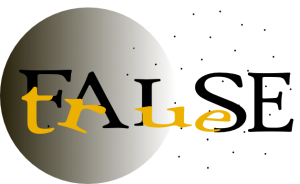My original intent for the title here was just “True or False Test Items” but one source pointed out that the best name is Alternative-Response. That source is https://www.msu.edu/dept/soweb/writitem.html and defines alternative-response as
… a special case of the multiple-choice item format. There are many situations which call for either-or decisions, such as deciding whether a specific solution is right or wrong, whether to continue or to stop, whether to use a singular or plural construction, and so on. For such situations, the alternative-response item is an ideal measuring device.
It goes on to point out the advantages of this item type:
Since only two options are possible, alternative-response items are generally shorter, and, therefore, require less reading time. Students may respond to more alternative-response items than other types of items in a given length of time.
But there is a major disadvantage: “students have fifty-fifty probability of answering the item correctly by chance alone.”
It suggests making up for this by offering “a larger number of alternative-choice items than of other types of items in order to achieve a given level of test reliability.”
There are other advantages and disadvantages, such as these offered by http://www.iub.edu/~best/pdf_docs/better_tests.pdf, which only addresses true-false items.
Strength: They are relatively easy to write.
Limitation: Items are often ambiguous because of the difficulty of writing statements that are unequivocally true or false.
To me this seems like a contradiction: How can they be easy to write but difficult to make unambiguous? This same source offers tips on writing good true-false items which we will address in the next post.
This source: http://www.k-state.edu/ksde/alp/resources/Handout-Module6.pdf brings up some other points on true-false items.
Good for:
- Knowledge level content
- Evaluating student understanding of popular misconceptions
- Concepts with two logical responses
Advantages:
- Can test large amounts of content
- True-false are adaptable to the measurement of a wide variety of learning outcomes
- Quick and easy to grade
- If constructed well, can be highly reliable in assessing student knowledge
Disadvantages:
- It is difficult to discriminate between students that know the material and students who do not
- Individual true-false items are less discriminating than individual multiple choice items
- There is a tendency to write trivial true-false items, which lead students to verbatim memorization
- True-false items are not amenable to concepts that cannot be formulated as propositions
- The extent of students’ command of a particular area of knowledge is indicated by their success in judging the truth or falsity of propositions related to it
Bloom’s Taxonomy is of concern for us here, too. Most sources I read indicate these types of questions items address only the first level of Bloom’s, Knowledge. We saw that above with the source listing “Good for” bullet points. Other sources say it bluntly:
True and false questions are best used when you are looking to test a student’s recall ability of specific facts or knowledge.
(Source: http://www.helpteaching.com/about/how_to_write_good_test_questions)
However this source, http://www.iub.edu/~best/pdf_docs/better_tests.pdf, makes this statement:
Instructors generally use true-false items to measure the recall of factual knowledge such as names, events, dates, definitions, etc. But this format has the potential to measure higher levels of cognitive ability, such as comprehension of significant ideas and their application in solving problems.
It goes on to give four examples, the first of which is just recall of facts but the others require the student to recall the important information and apply it correctly in order to answer without guessing.
T F 1. Jupiter is the largest planet in the solar system.
T F 2. If Triangle ABC is isosceles and angle A measures 100 degrees, then angle B is 100 degrees.
T F 3. If a distribution of scores has a few extremely low scores, then the median will be numerically larger than the mean.
T F 4. The larger the number of scores in a distribution, the larger the standard deviation of the scores must be.
(In case you were wondering, the answers are T, F, T, F.)
The first example above measures recall of a specific fact. The other examples, however, show how a true-false item can be written to measure comprehension and application.
We can see that true-false, alternative-response type questions have the potential to address higher levels of Bloom’s as well as cover a large portion of course material with minimal reading on the student’s part. This question type can benefit our exams if its strengths and weaknesses are considered carefully when being used.
In the next post we will look at the recommendations for writing quality alternative-response questions.



Recent Comments